Tours, Sights, History, Events in the Old Jewish District
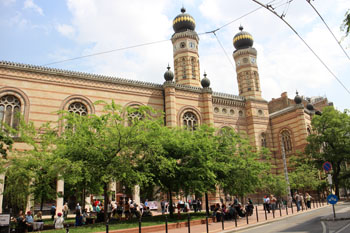
The Jewish Quarter of Budapest (district VII.) is packed with historic and religious sights including the:
- Great (Central) Synagogue in Dohány Street,
- Kazinczy Street Orthodox Synagogue
- Rumbach Street Synagogue
- Tree of Life monument, and the
- Jewish Museum.
Table of Contents
Table of Contents – Jewish Budapest
The Jews played an important role in the history of Pest, Buda, and Óbuda (Old Buda), and after the unification of the previous three, in Budapest’s development.
Despite their persecution and the terror of the 20th century, we can still find many monuments of the once thriving Jewish Budapest.
The former Jewish Quarter in district VII. has a quaint atmosphere with
- Characteristic people and culture
- Unique monuments
- Striking contrast of crumbling buildings, and
- Shiny new apartment blocks.
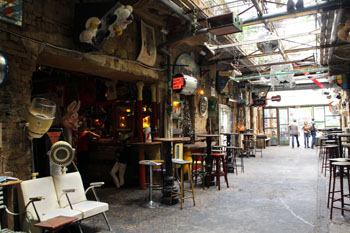
More and more unique cafes and bars (some of the famous ruin bars /romkocsma in Hungarian) are located in the Quarter:
- Szimpla kert,
- Fogaskert,
- Kőleves kert,
- Lokál Cafe & Bar), design centers, art galleries, bistros open in the area making it a hip place favoured by both locals and tourists.
Take your time to absorb this sometimes quirky part of the Hungarian capital!
Heritage Tours With Professional Guiding
These two Jewish heritage tours led by a professional guide in English show you the history and the most beautiful monuments of the historic Jewish district of the Pest side.
Tour Dates In 2023:
- 31. October – 01.May: Every Friday and Sunday at 10 am
- 01. May 31. October: Every Monday, Thursday, Friday and Sunday at 10 am
- Except: Jewish holidays and Saturdays
The Difference Between The Two Tours
Both tours cover the monuments and history of the Pest side.
- The Grand Tour is longer (3.5 hrs) and more detailed than the Basic tour (2 hrs). It also includes a cake with coffee in a kosher pastry shop.
- Take the Basic Tour (2 hrs) if you don’t have much time but want to learn about Jewish culture and history in a nutshell, as well as see the most important monuments.
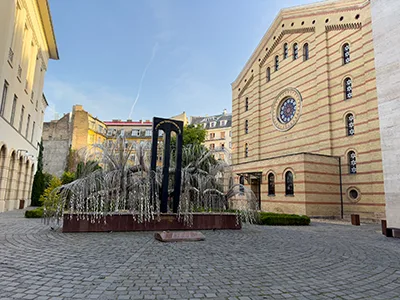
Select A Tour & Book Online
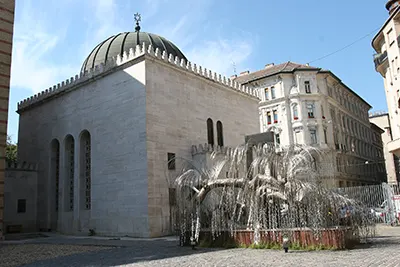
Jewish Heritage Guided Tour with Synagogue visit
Tour starts: 10:00
Duration: 120/240 min.
Price: From €59
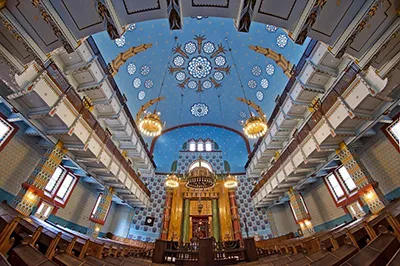
Kazinczy Synagogue Entry (with Optional Kosher Food Tasting)
Synagogue Opening Hours:
- Sun –Thurs: 10.00-18:00
- Friday: 10:00-16:00
- Saturday Closed
Price: From €9
Meeting point for both tours: in front of the Great Synagogue in Dohany Street,
Address: Dohány utca 2. Budapest, 1074
After payment you’ll automatically receive an E-Ticket.
Jewish Sights in Budapest
In Buda and Óbuda (Old Buda)
The first Jewish settlers arrived on the Castle Hill of Buda from Western Europe in the 1050’s in the areas of today’s Víziváros (distr. I.) and Óbuda (distr. III.).
By the 1200s Jews were in the most important economic positions in Buda.
This was a sore in many people’s eye so the representatives of the Catholic Church had persuaded King András II. to include in the Aranybulla (Golden Bull -special decree issued in 1222) that Jews were not allowed to fill in such positions.
Fortunately the fate of Buda’s Jewish community turned for the better during the reign of King Béla IV.
He invited merchants from Germany to make up for the loss of population caused by the Mongol invasion (1241-42). They paid substantial tax to the king too.
Buda’s Jewish quarter was on the western side of today’s Szt. György Square which were pulled down during the construction of the first Royal Palace.
Part of the historic settlement had been restored but can’t be visited due to reasons unknown.
Remains of the synagogue were excavated in 1964 part of which operates as a museum exhibiting Jewish relics and gravestones (opening hours: from 1st May till 31st October: Tue-Sun: 10.00-17.00, tickets: full price: 800 HUF, students, pensioners: 400 HUF.).
The renovated labyrinthine cellar system that can be visited as of recently includes a small, 2-3 sqm ritual bath, the mikveh.
Mikveh – Ritual Bath in the Castle
TIP: A historic Jewish ritual bath (mikveh) dated back to the 13. century has been unearthed recently at the Várkert Bazaar, a neo-Renaissance building complex at the foot of the Castle Hill.
The English-language guided tours start at 11.00 from Thursday till Sunday.
Tickets: 4 000 HUF/full price.
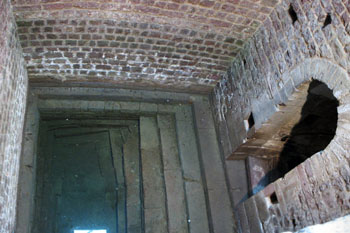
The 11th-century ruins can only be visited on a tour organised by Bupap that organizes tours for locals (guiding is in Hungarian).
Note: They have a 2-hour English language tour of the Pest side titled “the Vacant Jewish District” Price: 2 000/1 500 HUF.
The street level was 5 meters lower than today and the system includes a.
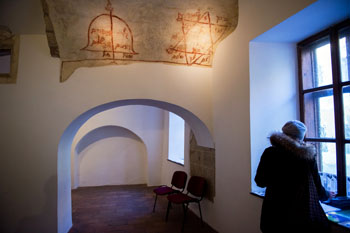
The Képes krónika mentions that there stood a synagogue and a mikveh at the Fehérvári gate in medieval times.
The Small Synagogue and the Medieval Jewish Prayer house at 26. Táncsics utca remind us of the everyday life of the Castle District’s Jewish community.
Jewish Community in Óbuda
During the 150-year Turkish reign the Jewish community of Buda vanished almost entirely.
In the 17th century German and Czech Jewish settlers established homes in Óbuda.
Buda and Pest didn’t permit settlement of Jews until the end of the 18th century.
Under the patronage of the noble Zichy family the Jewish colony of Óbuda developed into a prominent community.
In the 19th century the Reform Movement fought for giving equal rights to Jews too.
As a result of the movement’s efforts, Jews were free to settle down anywhere in Hungary including Pest and Buda. The Synagogue in Óbuda (Lajos utca 163., III. district) was built in 1820-21 in Classicist style.
Today it houses a TV studio.
Moses Muncz (1750-1831) was the rabbi of the community at that time whose grave you can see in the beautiful Jewish cemetery in Óbuda (Külső Bécsi út 369., III. district).
The memorial stone on the former Óbuda brick factory’s site marks the spot from where thousands of Jews were deported and sent to death under the terror of the Arrow Cross Party in 1944-45.
A nice garden surrounds the building of the secular Jewish Lauder Javne School (Budakeszi út 48. XII. district, bus No. 22. from Széll Kálmán tér) built in 1996.
While you’re there, take a look at the building of the old Jewish kindergarden next to the school.
Jewish Monuments in Pest
Synagogues – Tree of Life/Raoul Wallenberg Park – Martyrs’ Cemetery – Heroes’ Temple – Goldmark Hall – Jewish Museum & Archives – Carl Lutz Memorial – Sztehlo Gábor Memorial/Deák Square – Raoul Wallenberg Memorial/Erzsébet Square – Shoes on the Danube – Holocaust Memorial Center
The Old Jewish Quarter – District VII.
In the 19th century Pest became the center of Jewish Budapest.
Their religion, holidays and unique traditions made them form a community.
A Jewish quarter started to develop in
- Erzsébetváros and
- Terézváros (the VI. and VII. districts in Budapest).
The Synagogues in Pest
Three synagogues were built in the quarter: the most impressive of them is the Great Synagogue in Dohány Street built in 1859 in Moorish-Byzantine style
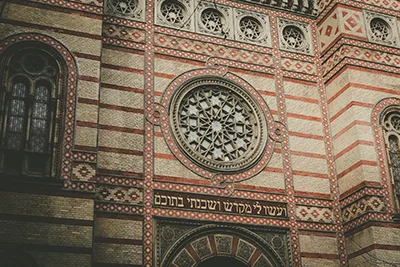
Jewish Heritage Guided Tour with Synagouge visit
Explore Budapest’s rich Jewish history and heritage on a captivating walking tour include the Dohany Street Synagogue
Tour starts: 10:00 / Duration: 120/240 min.
Price From €59
Great Synagogue in Dohány Utca
Address: Dohány utca 2., district VII.
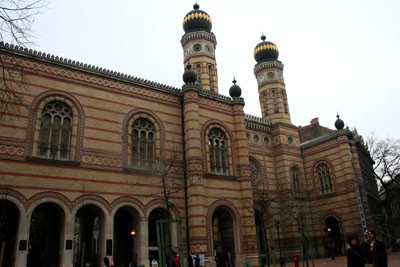
Opening Hours (same as the museum’s):
Winter (till 28. February 2023)
- Sunday – Thursday: 10.00 – 16.00
- Friday: 10.00 – 14.00
- Saturday: CLOSED
Spring & Autumn (01. March – 27. April and 01. October – 26. October)
- Sunday – Thursday: 10.00 – 18.00
- Fridays: 10.00 – 16.00
- Saturday: CLOSED
Summer (29. April – 30. September)
- Sunday – Thursday: 10.00 – 20.00
- Fridays: 10.00 – 16.00
- Saturday: CLOSED
Note: The Ticket Office closes half an hour before the synagogue’s closing time. The synagogue is also closed on major Jewish holidays.
Tickets
- Full price: 5 000 HUF (10 % discount with Budapest card),
- students, retirees: 3 800 HUF (10 % discount with Budapest card),
- children (ages 6-12): 1 700 HUF.
- family (2 adults + min. 2 children): 11 300 HUF
- free for kids under 6.
Includes:
- Guided tour of the synagogue (in English, German, French, Italian, Spanish, Hebrew and Hungarian languages)
- Visiting the Heroes’ temple,
- Raoul Wallenberg Memorial Garden with the Emmanuel Tree of Life
- The graveyard in the courtyard of the synagogue
- The lapidary
- Entry to the Jewish Museum & Archives
- Temporary exhibitions in the cellar
TIP: If you have limited time visit only the Great Synagogue and its surroundings.
The two-towered temple can occupy 6000 people.
It is a neolog synagogue meaning that the men and women sit in separate areas within the church. The service is in Hebrew, and the 5000-pipe organ provides music.
Tree of Life – Raoul Wallenberg Holocaust Memorial Park
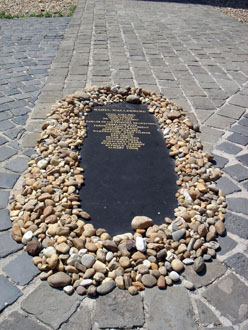
Location:
- In the inner courtyard of the Great Synagogue
Visiting The Park:
You can visit it only with a ticket to the Synagogue/Museum. The Tree of Life monument is visible from the street through the fence.
The silver metal weeping willow tree, the Tree of Life, stands in the Raoul Wallenberg Park.
It received its name after the Swedish diplomat who helped many Jews to escaping deportation in 1944-45.
The Tree stands in the garden of the synagogue and the Jewish Museum.
It’s a very moving and sad monument created by Imre Varga in 1991 with the support of the Emmanuel Foundation (founded by Tony Curtis actor).
Names of the victims disappeared or died during the Nazi terror are engraved on almost each of the 30,000 leaves.
Monuments commemorate the names of other heroes like Giorgio Perlasca and Per Anger.
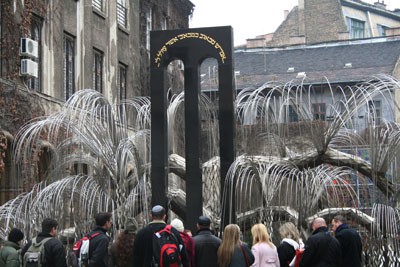
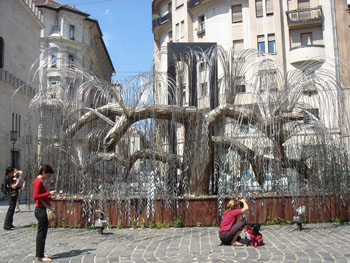
Martyrs’ Cemetery (Garden of Remembrance)
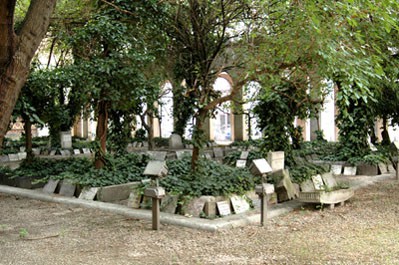
Location: in the courtyard of the Great Synagogue
A small plaque on the Wesselényi street side of the synagogue marks the spot where once the gate of the Budapest ghetto stood in 1944-45.
Not far from the plaque stands the small Garden of Remembrance where those who died in the ghetto were buried during 1944-45.
Their names are engraved in the stone gravestones.
Holocaust During World War II
According to Jewish customs cemeteries are not supposed to be placed next to synagogues, but this one in the garden of the synagogue, overlooking Wesselényi Street, was created out of necessity during WW II.
Until the 2nd half of 1944 Budapest was reluctant to cooperate with the Nazis to collect and sent Hungarian Jews into concentration camps, though the Hungarian government (lead by Miklós Horthy) stood on the side of the Germans.
Adolf Eichmann arrived in the Hungarian capital in December 1944 to carry out the deportation and execution of Hungarian Jews and Roma people.
A ghetto was established between Király utca and Dohány utca.
Because of the cold and the state of war the people in the ghetto weren’t able to carry their dead to the cemetery and bury them properly so thousands of corpses were left at the walls of the synagogue for 40 days.
During the liberation of the ghetto on 18. January, 1945 thousands of unburied dead victims lay on the streets. 1140 known and 1170 unknown martyrs were buried in 24 common graves in the courtyard of the central synagogue. The Dohány Street Synagogue is the only synagogue in the world that has a cemetery in its garden.
Hungarian Jewish Museum and Archives
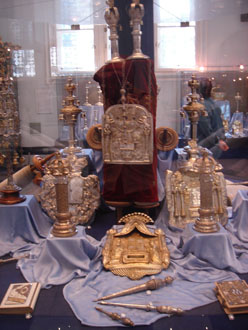
Address: Dohány utca 2., district VII., next to the Great Synagogue, M2 (red) metro Astoria station, bus 7, tram 49 Astoria stop
Opening Hours (same as the synagogue’s):
- Summer season(01. March – 31. October): Sun-Mon: 10.00 – 20.00, Tue – Thurs: 10.00 – 18.00, Fridays: 10.00 – 16.00, Saturdays: closed, from 01. June: Sun-Thurs: 10.00 – 20.00, Fri: 10.00 – 16.00, Saturdays: closed
- Winter season (01. Nov-28. Feb): Sun–Thurs 10.00 – 16.00, Fri 10.00 – 14.00, Saturday: closed, Website
- Jewish holidays: when the museum & synagogue are CLOSED: May 31., June 01., September 20. 21., 22., 29., October 04., 11. (open till 14.00), October 05., 06., 12., 13.,023., November 01., December 24.
Tickets
(includes visiting the synagogue, without guiding):
- Full price: 5 000 HUF (10 % less with Budapest card),
- Students, retirees: 3 800 HUF (10 % off with Budapest card),
- Children (ages 8-14): 1 700 HUF,
- Photo ticket: 500 HUF.
TIP: The Jewish Museum of Budapest on the left of the Great Synagogue has a collection of religious relics, historical documents, along with temporary exhibits. An arcade connects the museum with the modern-style Heroes’ Temple.
It’s best to connect visiting the museum and the synagogue.
Current Exhibitions In The Jewish Museum
- 100 Years – 100 Objects – the exhibit celebrates the 100th anniversary of the opening of the Jewish Museum in 1916 in a small apartment in Hold utca.
- The collection then consisted of 1500 pieces: mainly religious, ceremonial objects, and historical relics. To this special exhibit 100 objects have been selected that tell the rich and layered story of Hungarian Jewry.
- Rosenthal lived here: in the Goldmark Hall (Wesselényi u. 7.) – History of Jewish Pest from the late 18. century to present days.
- The turbulent story of Pest’s Jewish community is displayed in 10 time periods through 10 digital maps. A thorough insight into the everyday life of the people who lived there.
Heroes’ Temple
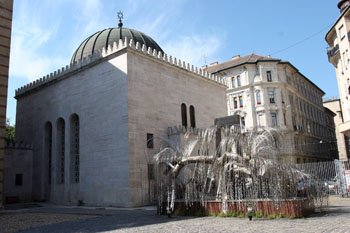
The temple connected with an arcade to the synagogue was built in 1931 according to the designs of László Vágó.
It can seat 186 people and is used for weekday worship services.
The Heroes’ Synagogue commemorates the 10 000 Hungarian Jewish soldier who gave their life for their country in the 1st World War.
A huge Star of David formed of Hebrew text adorns the entrance.
In winter the Friday evening and Saturday morning services are held here instead of the Great Synagogue.
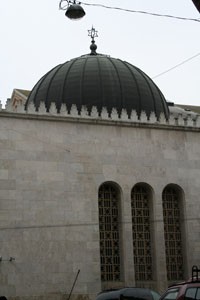
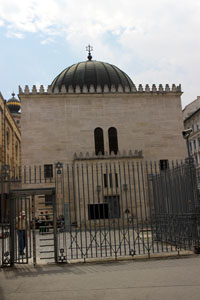
TIP: Not far from the former Jewish district stands the magnificent New York Palace (today a luxury hotel owned by the Italian Boscolo group) housing the legendary New York Cafe.
Just walk along Dob utca and you’ll end up at the imposing building at Erzsébet körút, a section of the Grand Boulevard (Nagykörút).
Goldmark Hall – Exhibition, Family Tree Research
Address: Síp utca 12. – Wesselényi utca 7., district VII., entrance from Wesselényi Str.
Opening Hours:
- Mon-Tue-Wed: 10.00 – 16.00,
- Thurs: 12.00 – 16.00,
- Fri: 10.00 – 14.00 tel: (+36 1) 413 5547
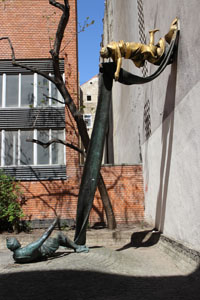
After the Raoul Wallenberg Park and the Heroes’ Cemetery you’ll find a 3-storey building which houses the Federation of Hungarian Jewish Communities (MAZSIHISZ) and is the centre of Budapest’s Jewish Community.
The 12 reliefs on the facade symbolize the 12 tribes of Israel with their names in Hebrew.
The building also gives home to the Goldmark Hall, a multifunctional cultural centre named after Károly Goldmark world-renowned composer.
The Hungarian Jewish Archives has created a new permanent exhibition about Pest’s Jewish Quarter at the back of the room.
On the 1st floor you’ll find the Gyökerek/Roots centre where databases and resources are available for those doing a family research.
Carl Lutz Memorial

At 10., Dob utca on a small square you’ll find the Carl Lutz Memorial standing against a white wall on a tiny plaza.
Lutz (1895-1975) as a Swiss diplomat had great connections with the Germans and Palestine thus he was able to help many Jews to flee from the terror.
The quote from the Talmud engraved on the metal plaque next to the monument says: “He who saves but one man is as if he had saved the whole world”
Rumbach Street Synagogue
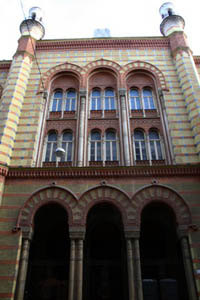
From Dob utca turn left on Rumbach utca where another striking Synagogue stands completed in 1872.
Walk along Rumbach utca then turn right into Király utca, walk until you reach Kazinczy utca on your right.
There stands the synagogue of Budapest’s Orthodox Jewish community.
Note: You can find additional resources on the history and heritage of the Hungarian Jew: Jewish Virtual Library
TIP: Kazinczy utca was renovated in 2012, it is now one of the city’s most popular nightlife spot with lots of great garden pubs, bistros, food bars.
Read more on Kazinczy Street.
Kazinczy Synagogue
Address: Kazinczy utca 29-31., district VII.
Opening Hours:
- 01 March – 31. October: Sunday – Thursday: 10.00 – 18.00, Friday (01 – 31. March): 10.00 – 13.00,
- 01 November – 28. February: Sunday-Thursday: 10.00-16.00, Friday (01. Apr – 31. Oct): 10.00 – 16.00,
- closed on Saturdays
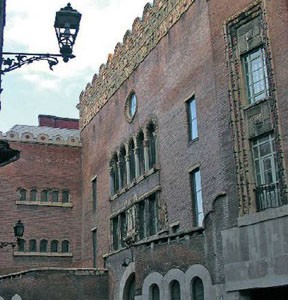
Tickets: From 9 EUR
The huge, Art-Nouveau synagogue is unmissable in the narrow Kazinczy Street.
It functions as the house of worship and teaching centre of Budapest’s Jewish community’s orthodox branch.
Béla Löffler and Sándor Löffler, disciples of Béla Lajta, designed the temple that was built between 1910-1913.
Besides the synagogue, the complex includes
- a Talmud school,
- a ritual bath (mikveh) and
- a kosher butcher.
From Kazincy Street turn right into Dob utca.
You’ll reach a large park with a playground, Klauzál tér. Locals relax and chat on the benches while looking after their kids.

Kazinczy Synagogue Entry (with Optional Kosher Food Tasting)
Synagogue Opening Hours:
Sun –Thurs: 10.00-18:00
Friday: 10:00-16:00
Saturday: Closed
Price From €9
Photos About Klauzál Square & Park
Klauzál Market
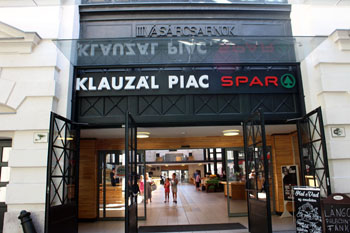
The Food Market on Klauzál Square was completely refurbished in 2015.
It was one of the 5 covered market buildings constructed at the end of the 19. century, including the famous Great Market Hall on Fővám tér.
Besides farmers selling vegetables and fruits, dairy shops, butchers there’s a large SPAR supermarket.
On the ground floor you’ll also find a bakery & cafe and there’s lángos – the locals’ street food on the gallery.
TIP: The Old Jewsih Quarter is famous for its eclectic mix of street art inlcuding the spectacular firewall paintings. Street artists painted colourful contemporary works on the grey walls giving the neighbourhood a vibrant, youthful vibe. Check out our favourite street art and firewall paintings in Budapest!
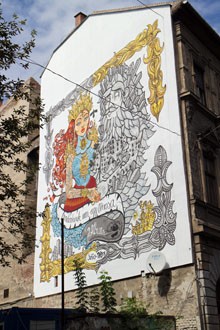
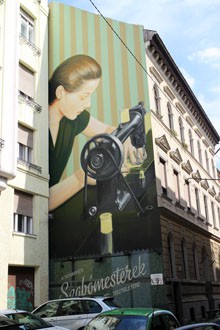
You can see more Firewall painting photos in our facebook album.
Monuments, Memorials in Downtown, District V.
Sztehlo Gábor Monument, Deák Ferenc Square
The monument was erected in 2009 in memoriam of Gábor Sztehlo (1909-1974), an Evangelist pastor who, on behalf of his bishop, organised the hiding of 1600 Jewish children in 32 homes with support of the Red Cross.
For this he received the Righteous Among the Nations title and the Yad Vashem medal in 1972.
Raoul Wallenberg Memorial, Erzsébet Square
The monument titled “Do not Forget!” by Gustav Kraitz was inaugurated in June 2014 in the downtown Erzsébet tér park.
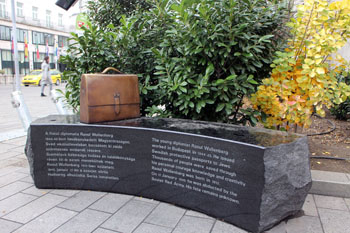
The bronze briefcase abandoned on a bench with the monogram R. W. in its front, reminds us that though we do not know what had happened to the Swedish diplomat after the Red Army had captured him.
His heroic deeds are not forgotten.
The Embassy of Sweden in Budapest initiated the creation of the uncommon monument as a gift to the Hungarian state.
Shoes on the Danube
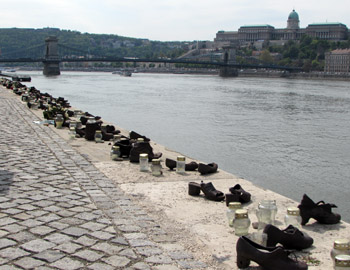
Location: Pest bank of the Danube, between the Parliament and the Chain Bridge
If you walk on the riverbank in Pest from the Parliament towards the Chain Bridge you’ll see pairs of shoes – men’s, women’s children’s – scattered on the pavement as if their owners have just jumped into the Danube.
The 60 pairs of cast iron shoes commemorate the Jews shot into the Danube by the Arrow Cross Party in the winter of 1944-1945.
According to current data, around 3 600 Jewish people living in Budapest were killed here during the cc. 3-month terror of the Hungarian Nazis.
The memorial – that was set up in 2005 -was initiated by Can Togay film director and he created it together with Gyula Pauer sculptor.
Restaurants & Cafes in the Jewish District of Budapest
If you’re tired of walking have a rest and a few bites in one of the numerous eateries (both kosher and non-kosher) situated in the area.
Fröhlich Confectionery
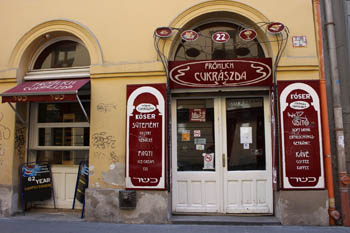
Address: Dob utca 22., district VII.
Open:
- Mon – Thurs: 09.00 – 18.00,
- Fri: 09.00 – 14.00,
- Sat: closed,
- Sun: 10.00 – 18.00
Tel: (+36 1) 266-1733
Although the building looks a bit run down these days, the flódni is fabulous.
It’s a traditional cake with layers of walnut, poppy seed and apple filling.
An unpretentious cafe ideal for a cake and coffee break when exploring Jewish Budapest.
Cirkusz
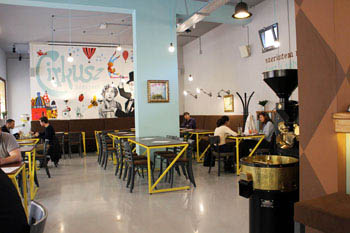
Address: Dob utca 25.
Open: every day: 08.30 – 16.30
A new place right across Fröhlich with bright colours, spacious interior and their very own coffee roaster.
Cirkusz is definitely will be one of my favorite places since they make coffee from freshly roasted beans.
Food is not bad either not to mention the homemade pies and cakes.
Socks Coffee
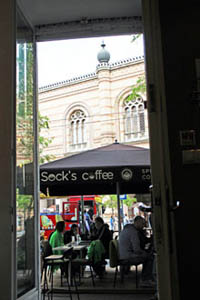
Address: Dohány utca 1., district VII.
Open: Mon-Sun: 08.00 – 20.00
Socks Coffee opposite the Synagogue offers specialty coffee drinks prepared from the freshly roasted beans of a Hungarian micro roaster, Lucky Cap.
A nice selection of
- cakes and pastries,
- fresh and delicious smoothies and
- other healthy treats are also available.
A great place for a coffee break before or after visiting the synagogue!
Osteria Fausto’s
Address: Dohány utca 5., district VII.
Open: Mon – Sat: 12.00 – 23.00
Tel: (+36 1) 269 6806
An exclusive Italian restaurant with top quality food. Always reserve a table.
Shailmar Indian Restaurant
Address: Dob utca 50., district VII.
Open: Mon-Sun: 11.30 – 16.00, and 18.00 – 23.30
Telephone: (+36 1) 352 0297, 352 0305
One of the top Indian eateries in Budapest, Shalimar received mixed reviews on restaurant review sites.
Some say the curry is very good, others claim that there are much better places offering Indian food in the city.
Read more about Shalimar on our Indian Restaurants page.
More Jewish Sights in Pest
Next to the synagogue in Páva Street opened the Holocaust Memorial Center (Holokauszt Emlékközpont) in 2004.
Holocaust Memorial Center
Address: Páva utca 39., X. district, M3 metro, trams 4,6 Ferenc körút stop
Opening hours: Tue – Sun: 10.00 – 18.00, ticket office closes at 17.00
Website: Holocaust Memorial Center
Admission:
- Free to children (the exhibits are recommended for children above 12), student’s groups (Advanced registration required), teachers, museologists, and senior citizens (70 and older).
- full price ticket: 1 400 HUF (50% discount with Budapest Card).
- Citizens of EEA between 62-70: 700 HUF
- Citizens of EEA between 6-26 years of age with international student card: 700 HUF
- Groups above 10: 1 100 HUF/person
Tickets are valid for the permanent and temporary exhibitions and for visiting the Páva utca Synagogue on the same day.
Guided Tours In The Páva Street Synagogue
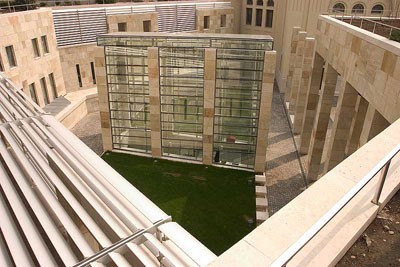
Guided tours available by appointment in Hungarian, English, German, French, and Hebrew.
Tour in Hungarian/groups under 20 persons: 6 300 HUF,
Tour in other language/groups under 20 persons: 8 800 HUF
The Center’s permanent exhibition titled From the Deprivation of Rights to Genocide depicts the
- Persecution,
- Suffering and
- Massacre of Hungarian Jews and Romas committed in the name of Nazi ideology.
See also our guide to Budapest Attractions, which includes lots of photos about our favorite sights in the city.
Jewish Events & Programs in Budapest
Jewish Summer Festival – a diverse festival with exhibitions, concerts, theater and dance performances, book, and craft fairs organized usually at the beginning of September.